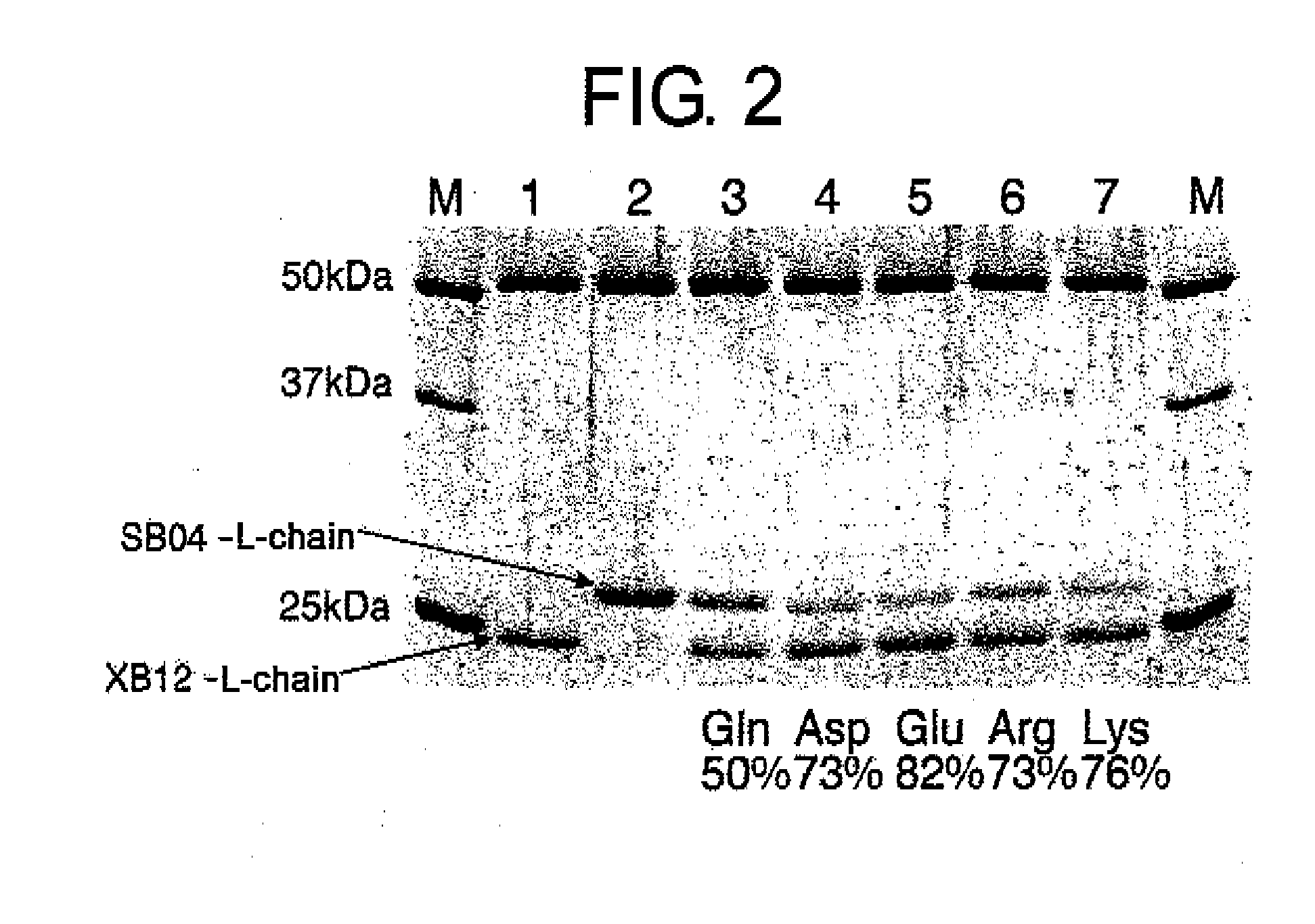Methods for Producing Polypeptides by Regulating Polypeptide Association
a polypeptide and association technology, applied in the field of polypeptide association regulation, can solve the problems of low production efficiency, swelling production cost, and the method of setting a knob and a hole in vh and vl does not sufficiently promote the formation of heterologous molecules, so as to achieve the effect of efficiently producing one and efficiently producing bispecific antibodies
- Summary
- Abstract
- Description
- Claims
- Application Information
AI Technical Summary
Benefits of technology
Problems solved by technology
Method used
Image
Examples
example 1
Production of Non-Neutralizing Antibodies Against Factor IXa (F.IXa)
1-1. Immunization and Hybridoma Production
[0379]Eight BALB / c mice (male, starting immunization at 6 weeks of age, Japan Charles River) and 5 MRL / lpr mice (male, starting immunization at 6 weeks of age, Japan Charles River) were immunized as described below with Factor IXaβ Enzyme Research Laboratories, Inc.). Factor IXaβ emulsified in FCA (Freund's complete adjuvant H37 Ra (Difco laboratories)) was administered subcutaneously at 40 μg / head as primary immunization. Two weeks later, Factor IXaβ emulsified in FIA (Freund's incomplete adjuvant (Difco laboratories)) was administered subcutaneously at 40 μg / head. Thereafter, boosters were given at one week intervals, a total of 3 to 7 times. After the elevation in serum antibody titer against factor IXaβ was confirmed by ELISA (enzyme linked immunosorbent assay) shown in 1-2, factor IXaβ diluted in PBS(−) (phosphate buffered saline that does not contain calcium ions and m...
example 2
Preparation of Non-Neutralizing Antibodies Against Factor X (F.X)
2-1. Immunization and Hybridoma Preparation
[0382]Eight BALB / c mice (male, staring immunization at 6 weeks of age, Japan Charles River) and 5 MRL / lpr mice (male, starting immunization at 6 weeks of age, Japan Charles River) were immunized with factor X (Enzyme Research Laboratories) as described below. For the initial immunization, factor X emulsified with FCA was subcutaneously administered at 40 μg / head. Two weeks later, factor X emulsified with FIA was subcutaneously administered at 20 or 40 μg / head. Thereafter, a total of 3 to 6 boosters were given at one week intervals. After the elevation of the titer of a serum antibody against Factor X was confirmed by ELISA as described in 2-2, Factor X diluted in PBS(−) was administered intravenously at 20 or 40 μg / head as a final immunization. Three days after the final immunization, mouse spleen cells were fused with mouse myeloma P3U1 cells according to a standard method us...
example 3
Construction of Chimeric Bispecific Antibody Expression Vectors
[0385]3-1. Preparation of Antibody Variable Region-Encoding DNA Fragments from Hybridomas
[0386]Total RNA was extracted from hybridoma XB12 that produced anti-F.IXa antibody or hybridoma SB04 that produced anti-F.X antibody using QIAGEN® RNeasy® Mini Kit (QIAGEN) according to the method described in the instruction manual. The total RNA was dissolved in 40 μL of sterile water. Single-stranded cDNA was synthesized by RT-PCR using the SuperScript cDNA synthesis system (Invitrogen) with 1-2 μg of the purified RNA as template according to the method described in the instruction manual.
3-2. PCR Amplification of Antibody H-Chain Variable Region and Sequence Analysis
[0387]HB primer mixture and HF primer mixture described in the report by Krebber et al. (J. Immunol. Methods 1997; 201:35-55) were prepared as amplification primers for the mouse antibody H chain variable region (VH) cDNA. Using 0.5 μL each of 100 μM HB primer mixtur...
PUM
| Property | Measurement | Unit |
|---|---|---|
| temperature | aaaaa | aaaaa |
| temperature | aaaaa | aaaaa |
| pH | aaaaa | aaaaa |
Abstract
Description
Claims
Application Information
 Login to View More
Login to View More - R&D
- Intellectual Property
- Life Sciences
- Materials
- Tech Scout
- Unparalleled Data Quality
- Higher Quality Content
- 60% Fewer Hallucinations
Browse by: Latest US Patents, China's latest patents, Technical Efficacy Thesaurus, Application Domain, Technology Topic, Popular Technical Reports.
© 2025 PatSnap. All rights reserved.Legal|Privacy policy|Modern Slavery Act Transparency Statement|Sitemap|About US| Contact US: help@patsnap.com



